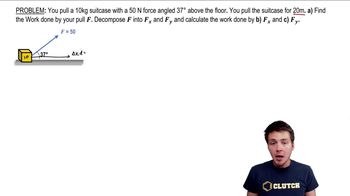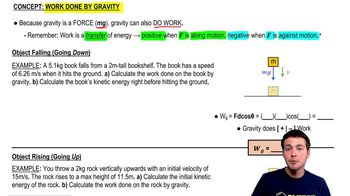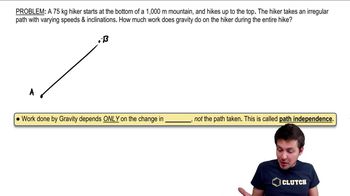>> So dot product is a mathematical tool for dealing with vectors. So if I have a vector A, and I have some other vector B, and I want to calculate the dot product, how do I visualize it? First off, I put the vectors together. And then I figure out the angle between them. The dot product is this -- A dot B is defined as magnitude of A times magnitude of B times cosine of the angle between them. It's the projection of one vector onto the other. This is a scalar. So this is known as the scalar product. So if you hear those words, it's the same thing as dot product -- dot product or scalar product -- because there's no vectors on the right-hand side here, okay. You took two vectors and got rid of the vector signs by writing it as this scalar product. So back to the question that we just had. If we have C dot C, what do we get? We get magnitude of C times magnitude of C times cosine of the angle between them. What's the angle between C and C? Zero. And cosine of 0 is 1, and so we do just get C squared. So dot products we're going to use a lot in terms of work. Later on, you're going to learn about cross products, which becomes AB sine theta. Let's think about Cartesian coordinate system. If we have our good, old Cartesian coordinate system, xyz, and we think about the unit vectors, the one along x we call the i hat. The one along y we call j hat. The one along z we call k hat. Those things have magnitude of 1, but they have different directions. So if I think about the dot product, i hat dot j hat, what do I get? I get the magnitude of i hat, which is 1. I get the magnitude of j hat, which is 1. And then I get cosine of the angle between them. What's the angle between i hat and j hat? Ninety degrees. Cosine of 90 degrees is 0. And so i hat dot j hat is 0. Likewise, j hat dot k hat is 0. k hat dot i hat is 0. It's good to remember these things because when you do dot products between vectors, it's going to simplify quite a bit because a lot of those terms are going to be zero. So let's go back to our definition for work. Work we said was f cosine theta delta x. But that looks a lot like this dot product right here. So can we just write it like this -- f dot delta x -- where I put vector signs on top of those things? And the answer is, of course, yes, we can do that. Displacement's a vector. Force is a vector. There's an angle between them, and so we can calculate theta and write down the dot product for those two. Okay, so this is getting more general to the definition of work, but we need to do one more step, which is if the force is varying over that distance, we have to take that into consideration. And so in general, work is the integral of f dot dx. They might write it with an s in your book, ds. It's whatever path you're taking, okay. So the force applied over the particular path. Okay, let's see how that works for something that we understand, like gravity. So gravity says objects are pulled towards the center of the earth. If I want to lift an object, I'm going to have to apply a force to it. And let's say we lifted a height h by applying a lifting force. And that lifting force doesn't have to be any bigger than mg, right. Here's my object. I'm going to lift it by applying mg to it, and it's going to go up a distance h. Let's calculate the work now by this definition. The work due to lifting it is going to be the integral of F lift dotted with, why don't we call it y since we're going vertically, okay. So we just rewrote this definition right here. All right. But we know what F lift is equal to. F lift is just going to be a magnitude of mg, but let's figure out what the angle is to put right here. What's the angle between my lifting force and the displacement? Well, the displacement is up. The lifting force is also up. And so the angle between those two is zero degrees. Cosine of 0 is 1. And so we're just left with integral F lift dy. And now we know exactly what that is. F lift is mg. We still have our dy, and we're going to lift it from zero to h. mg is a constant, and so that comes out in front of the integral. And if I integrate y, if I integrate dy from zero to h, I just get y evaluated zero to h, and that, of course, becomes mgh, which we already knew, right. We knew that gravitational potential energy was mgh. So what does this mean? What it means is I've done work lifting this box, but that work is energy. It has to go into something. What does it go into? It goes into the gravitational potential energy of the box such that if I let the box go, it will fall back down, okay. All right, good.
Table of contents
- 0. Math Review31m
- 1. Intro to Physics Units1h 23m
- 2. 1D Motion / Kinematics3h 56m
- Vectors, Scalars, & Displacement13m
- Average Velocity32m
- Intro to Acceleration7m
- Position-Time Graphs & Velocity26m
- Conceptual Problems with Position-Time Graphs22m
- Velocity-Time Graphs & Acceleration5m
- Calculating Displacement from Velocity-Time Graphs15m
- Conceptual Problems with Velocity-Time Graphs10m
- Calculating Change in Velocity from Acceleration-Time Graphs10m
- Graphing Position, Velocity, and Acceleration Graphs11m
- Kinematics Equations37m
- Vertical Motion and Free Fall19m
- Catch/Overtake Problems23m
- 3. Vectors2h 43m
- Review of Vectors vs. Scalars1m
- Introduction to Vectors7m
- Adding Vectors Graphically22m
- Vector Composition & Decomposition11m
- Adding Vectors by Components13m
- Trig Review24m
- Unit Vectors15m
- Introduction to Dot Product (Scalar Product)12m
- Calculating Dot Product Using Components12m
- Intro to Cross Product (Vector Product)23m
- Calculating Cross Product Using Components17m
- 4. 2D Kinematics1h 42m
- 5. Projectile Motion3h 6m
- 6. Intro to Forces (Dynamics)3h 22m
- 7. Friction, Inclines, Systems2h 44m
- 8. Centripetal Forces & Gravitation7h 26m
- Uniform Circular Motion7m
- Period and Frequency in Uniform Circular Motion20m
- Centripetal Forces15m
- Vertical Centripetal Forces10m
- Flat Curves9m
- Banked Curves10m
- Newton's Law of Gravity30m
- Gravitational Forces in 2D25m
- Acceleration Due to Gravity13m
- Satellite Motion: Intro5m
- Satellite Motion: Speed & Period35m
- Geosynchronous Orbits15m
- Overview of Kepler's Laws5m
- Kepler's First Law11m
- Kepler's Third Law16m
- Kepler's Third Law for Elliptical Orbits15m
- Gravitational Potential Energy21m
- Gravitational Potential Energy for Systems of Masses17m
- Escape Velocity21m
- Energy of Circular Orbits23m
- Energy of Elliptical Orbits36m
- Black Holes16m
- Gravitational Force Inside the Earth13m
- Mass Distribution with Calculus45m
- 9. Work & Energy1h 59m
- 10. Conservation of Energy2h 54m
- Intro to Energy Types3m
- Gravitational Potential Energy10m
- Intro to Conservation of Energy32m
- Energy with Non-Conservative Forces20m
- Springs & Elastic Potential Energy19m
- Solving Projectile Motion Using Energy13m
- Motion Along Curved Paths4m
- Rollercoaster Problems13m
- Pendulum Problems13m
- Energy in Connected Objects (Systems)24m
- Force & Potential Energy18m
- 11. Momentum & Impulse3h 40m
- Intro to Momentum11m
- Intro to Impulse14m
- Impulse with Variable Forces12m
- Intro to Conservation of Momentum17m
- Push-Away Problems19m
- Types of Collisions4m
- Completely Inelastic Collisions28m
- Adding Mass to a Moving System8m
- Collisions & Motion (Momentum & Energy)26m
- Ballistic Pendulum14m
- Collisions with Springs13m
- Elastic Collisions24m
- How to Identify the Type of Collision9m
- Intro to Center of Mass15m
- 12. Rotational Kinematics2h 59m
- 13. Rotational Inertia & Energy7h 4m
- More Conservation of Energy Problems54m
- Conservation of Energy in Rolling Motion45m
- Parallel Axis Theorem13m
- Intro to Moment of Inertia28m
- Moment of Inertia via Integration18m
- Moment of Inertia of Systems23m
- Moment of Inertia & Mass Distribution10m
- Intro to Rotational Kinetic Energy16m
- Energy of Rolling Motion18m
- Types of Motion & Energy24m
- Conservation of Energy with Rotation35m
- Torque with Kinematic Equations56m
- Rotational Dynamics with Two Motions50m
- Rotational Dynamics of Rolling Motion27m
- 14. Torque & Rotational Dynamics2h 5m
- 15. Rotational Equilibrium3h 39m
- 16. Angular Momentum3h 6m
- Opening/Closing Arms on Rotating Stool18m
- Conservation of Angular Momentum46m
- Angular Momentum & Newton's Second Law10m
- Intro to Angular Collisions15m
- Jumping Into/Out of Moving Disc23m
- Spinning on String of Variable Length20m
- Angular Collisions with Linear Motion8m
- Intro to Angular Momentum15m
- Angular Momentum of a Point Mass21m
- Angular Momentum of Objects in Linear Motion7m
- 17. Periodic Motion2h 9m
- 18. Waves & Sound3h 40m
- Intro to Waves11m
- Velocity of Transverse Waves21m
- Velocity of Longitudinal Waves11m
- Wave Functions31m
- Phase Constant14m
- Average Power of Waves on Strings10m
- Wave Intensity19m
- Sound Intensity13m
- Wave Interference8m
- Superposition of Wave Functions3m
- Standing Waves30m
- Standing Wave Functions14m
- Standing Sound Waves12m
- Beats8m
- The Doppler Effect7m
- 19. Fluid Mechanics2h 27m
- 20. Heat and Temperature3h 7m
- Temperature16m
- Linear Thermal Expansion14m
- Volume Thermal Expansion14m
- Moles and Avogadro's Number14m
- Specific Heat & Temperature Changes12m
- Latent Heat & Phase Changes16m
- Intro to Calorimetry21m
- Calorimetry with Temperature and Phase Changes15m
- Advanced Calorimetry: Equilibrium Temperature with Phase Changes9m
- Phase Diagrams, Triple Points and Critical Points6m
- Heat Transfer44m
- 21. Kinetic Theory of Ideal Gases1h 50m
- 22. The First Law of Thermodynamics1h 26m
- 23. The Second Law of Thermodynamics3h 11m
- 24. Electric Force & Field; Gauss' Law3h 42m
- 25. Electric Potential1h 51m
- 26. Capacitors & Dielectrics2h 2m
- 27. Resistors & DC Circuits3h 8m
- 28. Magnetic Fields and Forces2h 23m
- 29. Sources of Magnetic Field2h 30m
- Magnetic Field Produced by Moving Charges10m
- Magnetic Field Produced by Straight Currents27m
- Magnetic Force Between Parallel Currents12m
- Magnetic Force Between Two Moving Charges9m
- Magnetic Field Produced by Loops and Solenoids42m
- Toroidal Solenoids aka Toroids12m
- Biot-Savart Law (Calculus)18m
- Ampere's Law (Calculus)17m
- 30. Induction and Inductance3h 37m
- 31. Alternating Current2h 37m
- Alternating Voltages and Currents18m
- RMS Current and Voltage9m
- Phasors20m
- Resistors in AC Circuits9m
- Phasors for Resistors7m
- Capacitors in AC Circuits16m
- Phasors for Capacitors8m
- Inductors in AC Circuits13m
- Phasors for Inductors7m
- Impedance in AC Circuits18m
- Series LRC Circuits11m
- Resonance in Series LRC Circuits10m
- Power in AC Circuits5m
- 32. Electromagnetic Waves2h 14m
- 33. Geometric Optics2h 57m
- 34. Wave Optics1h 15m
- 35. Special Relativity2h 10m
9. Work & Energy
Intro to Calculating Work
Video duration:
8mPlay a video:
Related Videos
Related Practice













